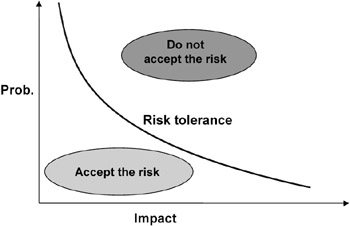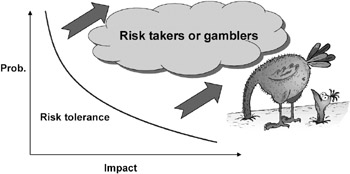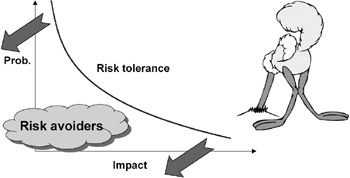What is risk tolerance?
|
Risk tolerance is the willingness of some person or some organization to accept or avoid risk. In any group of people there are gamblers or risk takers and there are nongamblers or risk avoiders. People who have a low willingness to accept risks and the consequences of risks are called risk avoiders. Those people who are willing to take risks are called risk takers.
It is important to know that people and organizations have differing risk tolerances. Some customers do not want to risk the delivery of the project they are paying for by taking a chance on something new. Other customers will welcome the opportunity if the danger is not too great. For example, if we were manufacturing a product like some of the products that are advertised on late-night television, we would probably have a relatively high risk tolerance for the product's failure. This is because the product is priced very low and is not going to put anyone's life in danger. Customers buying very low priced items can expect them to have a shorter useful life than the advertising indicates. If customers want a product that will last longer, they buy an item that is built better and is probably more expensive.
This ability to choose is related to risk tolerance. In the mind of the consumer there is a tolerance for risk, which is expressed in his or her willingness to spend money. A consumer who is interested in having a highly reliable product that will last a long time is willing to pay more to get these features. Another consumer who is not willing to pay more to get a better product will be more accepting of the risk that the product will fail.
Tell me more …
If we draw increasing impact and increasing probability on an X and Y axis, we can draw the locus of all points of equal severity as a line on the graph in Figure 8-11.

Figure 8-11: RISK TOLERANCE
Acceptable risks are any risks that are below and to the left of this locus of points of equal severity. Unacceptable risks are those risks that have a severity above and to the right of this severity line.
If we shift the severity line up and to the right, as in Figure 8-12, we are describing a person or an organization that is more of a risk taker. That is, the severity of the risks that one is willing to take is higher than before we shifted the line, and the person or organization shown is more of a gambler.

Figure 8-12: RISK TOLERANCE: GAMBLERS
If, on the other hand, we shift the line down and to the left, as in Figure 8-13, we are describing a person or organization that is less of a risk taker. That is to say that the severity of the risks that a person or organization is willing to take is less than before we shifted the line.

Figure 8-13: RISK TOLERANCE: AVOIDERS
In the classes we teach, we often perform the experiment of telling the students that we are willing to bet money on the roll of a single die, a cube with a number one through six on each side. (That's half of a pair of dice to you nongamblers.) In the bet we say that if the die comes up with a one or a two, we win. If the die comes up with a three, four, five, or six they win. The question is, "Who would be willing to play for a penny?" Nearly everyone stays in the game at this point. Then the stakes are raised to one dollar, and some of the people no longer want to play. As the stakes are raised higher and higher, more people drop out of the game. Eventually, unless there is a really hard-core gambler, everyone drops out of the game because the stakes are too high.
Even though the odds are very favorable, four chances out of six to win, when the bet is high enough, people will not play because the pain of losing is too great even when there are favorable odds. This is a great example of risk tolerance. Individuals and companies do the same thing with threats and opportunities. In risk tolerance we are concerned with people's personal values and views as well as the company's values and views. We may be dealing with a high-flying company that is willing to take many chances, but the individual who is representing the company may not be willing to stake his career on the risk you are suggesting. On the other hand, we do not want to be misled by the salesperson who is optimistic about everything until the sale is made.
Risk tolerance is somewhat describable in monetary terms. Our risk tolerance is how much we are willing to lose if the risk happens. In the case of a product that is sold to a consumer, the cost of the failure of the product might be the cost of the repair or replacement of the product if it fails. In the situation where someone's life is in danger, these decisions become much more important. The tolerance for a risk that is lifethreatening is very high indeed. This is because we cannot put a monetary value on human life.
|
EAN: 2147483647
Pages: 126